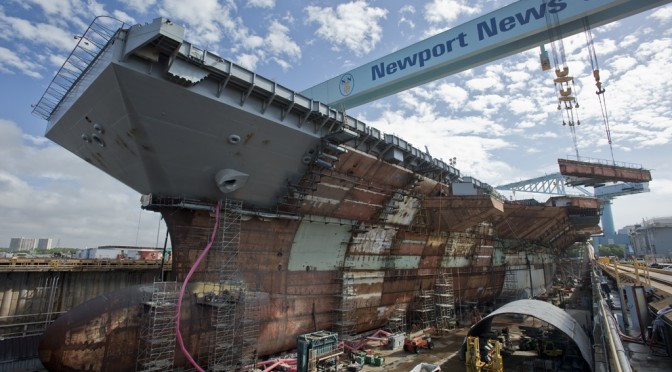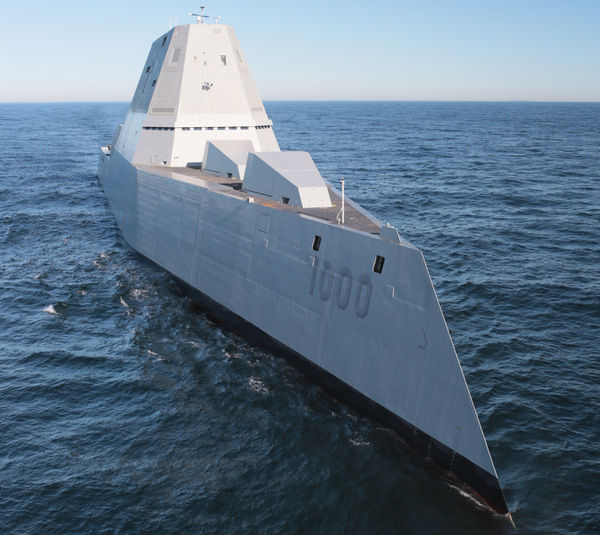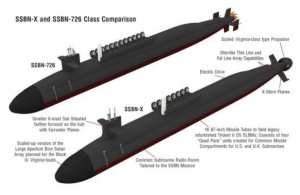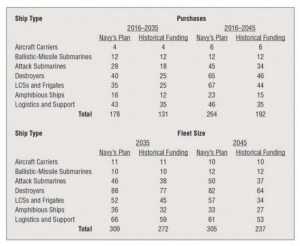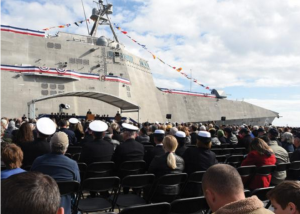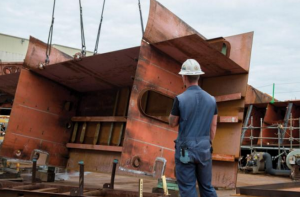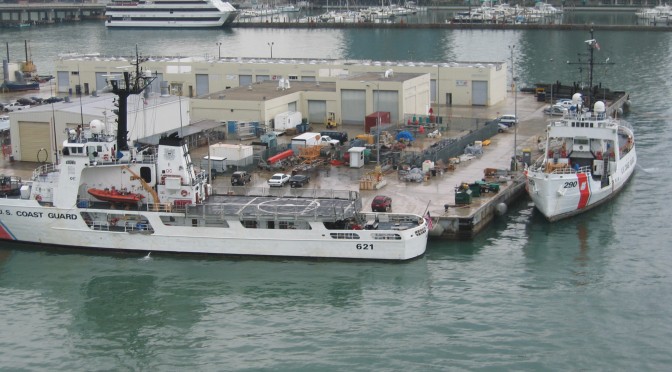By David Tier
America has grown weary of the post-9/11 wars. Long, drawn-out conflicts have worn down American resolve and left many defense officials nostalgic for “the good-old days” when adversaries were easier to describe and devoted military efforts toward preparing for conventional warfare. Seizing an opportunity, the U.S. Navy has capitalized on growing disillusionment and sought to exaggerate the military challenges posed by an ascendant China for parochial benefit in terms of gaining larger budgets and greater quantities of more expensive ships. The Navy should consider an external strategy review that accounts for efficiency as an aspect of its operating concept. This article reviews America’s current naval strategy and is divided into two parts. Previously, Part 1 analyzed U.S. naval defense strategy in light of 21st Century national defense threats. Part 2, below, will recommend changes to the Navy’s force structure to gain significant cost savings while still satisfying America’s naval defense requirements.
The Right-Sized Force
The Navy currently possesses 279 combat ships, including 11 supercarriers.1 An analysis of the platforms required to accomplish each mission reveals that, by procuring greater numbers of surface warfare ships such as frigates, the Navy could accomplish its five core missions while growing the number of ships in the fleet, lowering its average shipbuilding cost, and increasing its relevance in the defense arena to a greater extent than in more a decade. Rather than seeking to overcome advanced threats operating in their own territorial waters (an over-ambitious and possibly suicidal strategy unlikely to be needed), the Navy could come fully onboard with the existing 21st century task of discriminating between shadowy enemies that hide amidst innocent bystanders across the globe. The Navy could, indeed, provide a fleet with more total ships at a fraction of its planned budget and improve its brown-water capabilities necessary to confront pirates, terrorists, and less-capable regional adversaries by developing a larger, but less expensive fleet of 319 ships, and by maintaining eight carriers instead of the planned 11. In turn, this fleet would accomplish the Navy’s missions and yield significant cost savings.
The Navy’s first mission requires the nation’s defense from maritime attacks in naval theaters along the East and West coasts of the continental United States, off Alaska and Hawaii, and territories in the Caribbean Sea and Western Pacific Ocean. Since the main naval threat to the United States is primarily ballistic missile submarines, this mission requires the continuously operating presence of six multi-role naval task forces, one for each maritime defense area, primarily to conduct ASW and to a lesser extent ballistic missile defense (BMD).
The Navy would specifically tailor each task force to its geographic area and utilize advantageous aspects of the “distributed lethality” concept by deploying small surface action groups as well as independent ships and attack submarines forward to detect and track boomers, while positioning naval BMD assets in optimal locations complementary to land-based BMD systems in order to intercept either the most dangerous or most likely paths of inbound ballistic missiles, as necessary. In total, a force of six guided-missile cruisers, 12 guided-missile destroyers, 24 frigates, six oceanic surveillance ships, 12 attack submarines, 10 airborne ASW patrol squadrons, and major systems such as the Integrated Undersea Surveillance System (IUSS; e.g. SOSUS), and the Naval Ocean Surveillance System (NOSS) could reasonably accomplish the task.
Nuclear deterrence remains necessary to protect the nation from attack and, as is standard practice, eight ballistic missile submarines would continually patrol the seas to provide nuclear strike capability.2 Only anti-surface warfare (ASuW) capability for self-defense would be necessary in this mission since the Air Force and Air National Guard are well-equipped to defend the nation against surface threats within range of America’s shores.3 Therefore, this mission requires neither aircraft carrier nor expeditionary strike groups. The Navy should strictly focus on defending against direct military threats to the nation’s territory while the U.S. Coast Guard should maintain its national security VBSS role, since it enjoys comparative economic advantage in national security tasks while close to home.
The second mission requires the Navy to establish SLOC security to friendly foreign waters, as military necessity dictates. Naval forces would only need to perform this mission during wartime, as opposed to the first mission, which requires continuous deployment. Therefore, the Navy would not require an indefinite rotational sea presence to fulfill this mission. Employed with tactical wisdom, the Navy could economize forces by operating the first two missions in tandem while simultaneously taking advantage of geographic barriers to sea traffic in the North Atlantic, Southeast Asia, and Oceania as well as other channelized waterways, and could lessen the number of single-purpose ships separately tasked to secure commercial ships from threats they might encounter far from America’s coasts. It is possible that this mission could be performed with no further forces whatsoever; however, to conservatively guard against a wide-variety of threats and specific circumstances, the Navy should procure the additional capability to simultaneously escort two large convoys in the open ocean. This would allow commercial traffic to continue with minimal disruption.
In 2013, there was a median commercial traffic flow of 441 container ships per month unloading in U.S. ports.4 Assuming that an anti-shipping threat could not engage half of these ships either because their routes crossed oceans they could not effectively operate in, or due to the effectiveness of forces already listed, the Navy would only need to escort about 200 ships per month of conflict. The duration of Navy escort tasks in this mission could last as long as one month because, given sea-lane transit times, a ship might have to journey as long as 32 days to reach the furthest destinations.5 Kaufmann noted that a task force composed of one destroyer, nine frigates, and a supply ship could sufficiently escort 100 transports at a time.6 To ease the ASW burden on the surface ships somewhat as well as adding some minesweeping capability, an additional two attack submarines, airborne ASW patrol squadron, and a minesweeper7 per task force would round out the requirement. Therefore, to counter against the varied military threats to commercial shipping such as hostile attack submarines, long-range attack aircraft, surface vessels, and mines, the Navy could employ two task forces composed of a total of two destroyers, 18 frigates, two minesweepers, four attack submarines, their attendant support ships, and two airborne ASW patrol squadrons. With substantial ASW and ASuW capability, moderate AAW capability and, combined with Air Force tactical support, these forces would likely defeat any projected threat that could seek to deny American commercial shipping access to friendly ports. These forces could protect American commerce from the East Coast to the Suez Canal, from the West Coast to Sydney, or from either direction into shore destinations along the Indian Ocean for that matter. As before, this mission requires neither aircraft carrier nor expeditionary strike groups.
The third mission graduates from defensive missions and nuclear deterrence that each seek to guard American interests, to offensive conventional capabilities that seek to destroy enemy naval forces maneuvering in a theater of war. Since the 2012 National Defense Strategy calls for the U.S. military’s capability to defeat one regional aggressor while denying the objectives of a second,8 and since nothing yet suggested by the Trump Administration indicates this paradigm will significantly change, the Navy should only require the capability to defeat the maritime forces of one-and-a-half regional aggressors for this mission. This is a half-step down from the nation’s previous desire to procure forces that could simultaneously defeat the militaries of two discreet adversaries. The Navy could perform this third mission by adding two carrier strike groups (CSG) and two expeditionary strike groups (ESG) on top of the previously listed forces. Depending on the tactical situation and the naval commander’s judgment, these forces could operate either as one CSG and one ESG in each theater, or two CSGs in one theater and the two ESGs in the other. The CSGs give the Navy a significant ability to strike enemy surface combatants and attack aircraft, while the ESGs give the joint force commander the ability to raid enemy forces on land as well as some AAW, ASuW, and strike capability. Multiple carriers give the U.S. force the ability to operate round-the-clock. In total, this mission results in an additional force requirement of two aircraft carriers with their carrier air wings, two amphibious assault carriers with their multi-role fixed-wing aircraft, four cruisers, six destroyers, four frigates, three minesweepers, six attack submarines, two amphibious assault carriers, and their attendant support ships.
The fourth mission involves defeating anti-access strategies in order to gain access to contested theaters of operation. As with previous missions, gaining access adds to force requirements and the Navy can use forces already operating in their stead to contribute, so long as adding tasks does not compromise the previous missions. The Navy could employ a total of four carrier groups to accomplish this mission and realistically incur no more than moderate risk. In fact, in all but one conceivable instance, even four carrier groups might be overkill. In all other cases, significant airpower can be generated from land-based airfields. Furthermore, the Navy does not need any additional ESGs for this mission because it requires only gaining access to the theater, not establishing footholds on land or otherwise driving out ground forces while simultaneously conducting a holding action in another theater. Therefore, the Navy requires an additional two carriers, two cruisers, eight destroyers, six frigates, three minesweepers, four attack submarines, and the standard compliment of support ships for this fourth mission. Combined with the forces previously listed, including two ESGs, this total force enables the Navy to gain access to contested theaters of operation.
The fifth and final mission, power projection, defines the remaining forces that the Navy would need. Projecting power is an important capability to procure, and precedents established in the 1991 Gulf War and 2003 invasion of Iraq demonstrate the level of capability that the Navy needs to operate at peak. An additional two CSGs and three ESGs are necessary to defeat an adversary’s defense of his coastline and establish a foothold on land to allow continued operations further inland. Even under difficult conditions, with little allied support and no land-based staging area to prepare for an invasion, this total force of six CSGs and four ESGs would be a force too formidable for enemies to resist. The Air Force, other joint forces, and allies could hold adversaries at bay in other theaters if geography required the Navy to concentrate on a single maritime-focused theater but, most likely, joint and allied forces would also contribute to the Navy’s mission in substantial and meaningful ways. This force adds a requirement of two carriers, six cruisers, seven destroyers, three frigates, five attack submarines, six amphibious assault carriers, and their attendant support and supply ships to the fleet.
| Table 1. Summary of Proposed Fleet Changes | |||
| PLTFM \ QTY | CURR INV9 | NEW INV10 | Δ |
| CVN | 11 | 8 | -3 |
| CG | 22 | 23 | 1 |
| DDG | 62 | 44 | -18 |
| LCS/FF + FFG11 | 11 | 65 | 54 |
| SSN | 53 | 39 | -14 |
| LPD | 9 | 10 | 1 |
| LSD | 12 | 10 | -2 |
| AGOS | 5 | 18 | 13 |
| JHSV | 4 | 10 | 6 |
| MLP | 2 | 5 | 3 |
| HST | 1 | 10 | 9 |
| Carrier Air Wing | 9 | 8 | -1 |
These five missions result in total operational requirements of six carriers, 19 cruisers, 37 destroyers, 56 frigates, eight minesweepers, 33 attack submarines, eight ballistic missile submarines, eight amphibious assault carriers, 12 long-range airborne patrol squadrons, seven oceanic surveillance ships, and additional amphibious and support ships, air wings, helicopter squadrons, as well as the IUSS and NOSS. This force is not yet the total force the Navy needs in inventory, however. Since it would be nearly impossible to sail the entire fleet, the Navy needs additional ships to remain in port and allow for training, maintenance, as well as to compensate for potential combat losses.
The Navy insists that, due to maintenance and training requirements, only one-third of its carrier force may be available for routine deployment at any given time and, in an extended crisis, about half could deploy in support of combat operations.12 According to a naval force generation analyst, the Navy could put only six out of 10 carriers to sea to fight a war.13 The rate of routine deployment seems to be a bit better for the rest of the fleet, though, where approximately 40 percent of the ships are deployed at any time and greater than two-thirds are available in war.14
The fact that only such a small fraction of the fleet is deployable is simply unacceptable. The Navy must work to improve its deployment rates to achieve a capability where at least 80 percent of the fleet could put to sea if necessary. One possible solution would be to increase the number of ships homeported overseas to decrease transoceanic transit times. Although this could increase maintenance costs by 15 percent,15 the increased operational tempo would reduce the number of ships necessary to hold in maintenance and training reserve. Moreover, the resulting procurement savings would significantly outweigh the increased maintenance costs. Another possible solution could be to invest more research-and-development funding into operational readiness improvement rather than developing new platforms. This would help advance new technologies and methods that could enable ships to require less maintenance, last longer, and generally increase readiness.
Regardless of how the Navy decides to improve its deployment rates, a solution must be found. In contrast, even the Air Force, despite the complexity of possessing the most sophisticated and technologically advanced equipment in all the Services, has historically been able to maintain consistent readiness rates above 80 percent for their critical combat platforms.16 Perpetually withholding so many ships in reserve is wasteful, inefficient, and may be the result of institutional complacency. In a declared war, a 11-carrier Navy would ideally confront an enemy with all 11 of its carriers. Likewise, an eight-carrier Navy should bring all eight carriers to bear. Once satisfying this requirement, the Navy would require enough ships so that 40 percent of its inventory would be enough to conduct the continual deployments described in the first mission, and that the total requirements across all missions should compose no less than 80 percent of that inventory.
These stipulations produce the total number of ships that the Navy would need. In sum, the Navy would need 319 ships including eight carriers, 23 cruisers, 12 fixed-wing ASW patrol squadrons, 39 attack submarines, 12 ballistic missile submarines, 10 amphibious assault carriers, and 18 oceanic surveillance ships.17 Having determined the fleet’s size, we can determine its cost and compare it to the Navy’s present and planned inventories to ascertain potential savings.
Comparison, Trade-offs, and Budget Implications
The Navy’s inefficiently planned fleet provides three more supercarriers, 18 more guided-missile destroyers, but surprisingly, one less guided-missile cruiser than the efficient fleet proposed here. Although providing the Navy more firepower, this plan sinks a lot more money. On the other hand, the fleet proposed here adds 13 frigates and four amphibious assault ships to what the Navy plans, returns dedicated minesweepers to the fleet, and adds a small number of support ships as combat multipliers.18 This force sacrifices some firepower but improves brown-water niche capabilities that are more appropriate for the present and future strategic environment. Overall, it adds 13 ships over the current plan and is much more economical.
The savings come from the big ticket items. A Ford-class carrier costs almost $13B to build.19 Procuring its air wing costs another $5.5B.20 Ticonderoga-class cruisers cost $1B21 and Arleigh Burke-class destroyers $1.8B each.22 The savings would be even greater for destroyers if one considers that Zumwalt-class could cost an estimated $4.4B per ship.23 Alternative platforms are far less expensive. Independence-class littoral combat ships cost about $479M,24 and Avenger-class mine counter measure vessels cost $277M.25 Consequently, there are force mixes considerably cheaper and more germane to the Navy’s missions than large numbers of aircraft carriers. In comparison, the proposed fleet saves $63 billion over the 40-year plan in procurement and shipbuilding costs alone (see Table 2). However, life-cycle and total acquisition savings would be even greater. Spar Associates, Inc. estimates that capital costs are only about 18 percent of life-cycle costs.26 Therefore, the proposed fleet could yield $340 billion in savings over the duration of the Navy’s shipbuilding plan.
| Table 2. Comparison of Planned vs. Proposed Fleet27 | ||||
| PLTFM \ QTY | PLND28 | PROP29 | Δ | PRCRMT SVGS ($B) |
| CVN | 11 | 8 | -3 | 38.04 |
| CG + DDG | 88 | 67 | -21 | 31.4 |
| LCS/FF30 | 52 | 65 | 13 | -6.227 |
| SSN | 48 | 39 | -9 | 23.4 |
| Amphibs | 33 | 37 | 4 | -7.4 |
| SSBN | 12 | 12 | 0 | 0 |
| SSGN | 0 | 0 | 0 | 0 |
| MCM | 0 | 10 | 10 | -2.77 |
| JHSV | 10 | 10 | 0 | 0 |
| Supply ships | 29 | 32 | 3 | -1.5 |
| Other | 23 | 39 | 16 | -12.16 |
| Total | 306 | 319 | 13 | 62.783 |
Furthermore, in offering capabilities more likely to be used rather than far-fetched shore assaults originating from the open ocean, the Navy would improve the utility it has lacked for stability operations in the Middle East. The Navy would improve its counter-piracy and counterterrorist capabilities by increasing its number of small surface combatants. One could quibble about the mixture of frigates, minesweepers, and support ships in the Navy’s portfolio of small vessels, but the point is that these platforms are more important than task forces designed to project power in the current strategic environment. Instead of exaggerating carrier requirements, the Navy should concentrate its investments on less expensive platforms such as surface combatants, submarines, and shore-based patrol aircraft. The Navy should not completely relinquish its capability to establish sea-based air superiority, of course, and should increase its support of the Marines’ capability to seize footholds on land. However, the Navy should field an appropriate level of fixed wing airpower to support national military interests without overly burdening the defense budget.
One implication in reducing the number of carriers would be to decrease steady-state operational deployments. Only two or three carriers are presently deployed at a given time, with two deployed and one in-transit to or from home station.31 If the Navy reduced its carrier inventory from 11 to 8, only two carriers would be at sea during normal, peacetime conditions. Carrier deployments deter aggression and reassure allies, and reducing deployments would incur the risk that only one carrier would be actively operating in a forward area at a time while a second carrier transited to or from home station. Nevertheless, this transiting carrier could always turn around and move anywhere in the world in an average of 12 days32 and therefore at least two carrier groups would remain at sea at all times. If combatant commanders sought to request greater carrier presence than this force could provide, then the Department of Defense should audit the overall presence requirements that commanders request, and seek more inexpensive carrier substitutes such as Air Force tactical fighter squadrons where possible. Even deploying Navy carrier air wings without their embarked carrier would be a far cheaper solution. There are few places where a naval sea base would be necessary.
There has been good news for carrier enthusiasts recently, however, now that the Navy increased its carrier inventory to 11 with the commissioning of USS Gerald R. Ford, CVN-78, on July 22, 2017.33 Under the planned acquisition schedule, the Navy will even commission a twelfth supercarrier in 2020, then alternately vary its carrier supply between 12 and 11 through 2040 by replacing carriers at nearly the same time they retire. The Navy’s plan is to then lower its inventory to 9 carriers after 2053.34 Rather than seeking to decommission excess ships ahead of schedule and quickly reduce the carrier inventory to 8 as this proposal might imply, however, it would be more efficient to finish building the carriers already under construction, allow existing carriers to serve their planned lives, and then allow the inventory to decrease without replacing retiring carriers until the correct level has been reached. As an alternative to the Navy’s present plan, if the Navy ceased carrier procurement after completing the second Ford-class carrier under construction and allowed existing carriers to complete their service and retire in their 50th year, and then begin replacing carriers only when the inventory dipped to 8, the Navy could cancel construction of three aircraft carriers in the next 35 years and save $38 billion in current dollars for carrier procurement costs alone.35
Altogether, the Navy could save an estimated total of $340 billion over 40 years. Though one of Candidate Donald Trump’s expressed desires while campaigning for President was to build a 350-ship Navy, the Administration’s budget has not yet supported that desire with funding requests.36 For whatever additional future funding requests the Trump Administration makes for the Navy, this proposal would also add that margin to potential savings. Some might argue that by allowing 16 years to elapse between the construction of CVN-79 and CVN-80 as proposed here, America’s carrier-building infrastructure might atrophy. This would certainly be another risk, but what are the opportunity costs for continuing to build carriers at the planned rate, and are their national defense priorities that are more important to pursue?
Would it be Worth it?
In the grand scheme of the federal budget, $340 billion over 40 years may not seem like much. However, it could provide for close to four years of an Operation Enduring Freedom (OEF)-like ground force deployment at the 2014 level of activity,37 or many smaller-sized but longer-lasting counterterrorism operations. This leads to a final question for decision-makers to consider: would the benefits gained in providing four more years of an OEF-sized operation outweigh the risk incurred by allowing the Navy’s carrier fleet to decline from 11 to 8?
The answer is “yes.” Consider the fact that there were no terrorist attacks against the United States during the entire time the Bush Administration pursued aggressive military action in Iraq, but there have been several attacks on American soil since the end of Operation Iraqi Freedom. It is not a coincidence. Military operations in the Middle East probably reduced the threat to the U.S. by attracting terrorist activity elsewhere. The operation allowed military personnel to confront terrorists on foreign soil rather than subjecting police and homeland defense officials like Transportation Security Agency officers to deal with attacks at home. If American military activity in the Middle East decreases, the number of attacks against the U.S. will rise…perhaps catastrophically.
On the other hand, if operations in the Middle East continue at their present rate such as in Afghanistan, or if ISIS, Yemen, or some other potential problem area requires commitment of ground forces, the nation will find its ground forces already exhausted, overburdened, and insufficiently provided for in order to accomplish new tasks. Financial resources will have to be diverted from other accounts to accommodate them, and waiting until the last moment will have further consequences. High operational tempo has already eroded the training and readiness of America’s ground forces. America should pursue a grand strategy of democratization in these troubled regions, and this requires a greater number of resources dedicated to ground operations in the Middle East which, in turn, will reduce the number of terrorist attacks against the United States.
Although civilian leadership might abhor the idea of continued ground operations in the Middle East, military advisors must recognize reality and advise apolitically. Ground combat operations must continue for the sake of American national security, and each Service needs to perform its role to support them even if it means taking cuts in favored programs like aircraft carriers. As Kaufmann found 30 years ago, the Navy should “knock it off” with attempts to maintain a double digit-sized carrier fleet and should recommend against the pivot to the Asia-Pacific for the nation’s greater defense interests. To do otherwise puts all Americans – civilians and service members – at risk.
David Tier is a Lieutenant Colonel in the U.S. Army and serves as a strategic plans and policy officer. He holds a Master in Public Administration from the Harvard Kennedy School, has served three combat tours of duty in Iraq, a tour of duty in the Pentagon, and has authored several articles.
The views expressed here are those of the author and do not necessarily reflect the policy or position of the U.S. Government, Department of Defense, or any of their components.
References
[1] Department of the Navy, “Naval Vessel Register,” as of August 1, 2017, available online at http://www.nvr.navy.mil/NVRSHIPS/FLEETSIZE.HTML
[2] Hans M. Kristensen, “Trimming Nuclear Excess: Options for Further Reductions of U.S. and Russian Nuclear Forces,” (Washington, D.C.: Federation of American Scientists, December 2012), 15.
[3] As demonstrated by routine air intercepts of Russian reconnaissance flights as well as potential homeland security threats.
[4] USDOT waterborne trade statistics (available at http://www.marad.dot.gov/library_landing_page/data_and_statistics/Data_and_Statistics.htm) indicate that 1.259B metric tons of goods were shipped into an out of American ports in 2013. Since the median container ship holds about 5000 twenty-foot equivalent units (TEUs), this yields about 441 container ships per month in and out of U.S. ports. According to page 2 of the CRS report titled “Port and Maritime Security: Background and Issues for Congress” by John F. Fritelli dated May 27, 2005, there were on average 500 ships per month transiting U.S. ports in 2003, which is in the same ballpark as figures derived for 2013.
[5] See powerpoint press release by Rear Admiral William K. Lescher, USN, “FY 2015 President’s Budget,” (Washington, D.C.: Department of the Navy, March 2014), 3.
[6] William W. Kaufmann, A Thoroughly Efficient Navy (Washington, D.C.: The Brookings Institution, 1987), 64.
[7] Although the Navy has recently decided to discontinue dedicated minesweeping platforms in favor of the mine countermeasure mission package of the littoral combat ship, minesweepers are more cost effective for the particular task. According to Michael Zennie at The Daily Mail, an Avenger-class minesweeper costs $277M per ship, while according to a Congressional study, littoral combat ships cost $479M per ship. Accordingly, the Navy should continue to procure minesweepers rather than replacing them with littoral combat ships/frigates; see Ronald O’Rourke, “Navy Force Structure and Shipbuilding Plans: Background and Issues for Congress,” (Washington, D.C.: Congressional Research Service, March 3, 2015), 2; and Michael Zennie, “The U.S. Navy’s $277 Million pile of scrap,” January 30, 2013, available online at http://www.dailymail.co.uk/news/article-2270395/U-S-Navy-hack-61million-minesweeper-ship-pieces-remove-sensitive-reef-near-Philippines.html, accessed on April 7, 2015.
[8] Department of Defense, “Sustaining U.S. Global Leadership: Priorities for 21st Century Defense,” (Washington, DC: DOD, January 2012), 4.
[9] Ibid.
[10] See appendix for a complete listing of platforms required, including support ships.
[11] The Navy is seeking to replace its remaining Oliver Hazard Perry-class frigates with the new littoral combat ship. Just a short time ago, Perry-class frigates were slated to retire without replacement and the littoral combat ship was intended to fulfill a different, but overlapping, set of brown-water capabilities supposedly not addressed by the frigate. According to the Secretary of the Navy, however, the littoral combat ship will be reclassified as a frigate and given “FF” hull registry numbers. This acknowledges the need for a traditional frigate and reduces the distinction between the tasks littoral combat ships were intended to perform that Perry-class frigates had not already done. For the purposes of this analysis, littoral combat ships and frigates will be grouped in the same category as frigate, and consider the main role of a frigate to be as an escort to high-value ships. The frigate is primarily an ASW platform, but can also perform secondary roles such as ASuW, AAW, and other general-purpose tasks to a lesser extent. Frigates can perform brown-water tasks by utilizing helicopter search as well as with small-craft borne visit, board, search and seizure (VBSS) teams; See Sam Lagrone, “SNA: Modified Littoral Combat Ships to be Designated Frigates,” USNI.org, January 15, 2015, available online at http://news.usni.org/2015/01/15/sna-modified-littoral-combat-ship-class-changed-fast-frigate, accessed on March 30, 2015.
[12] U.S. Navy Captain(Ret.) Marty Erdossy, “Why Does The United States Only Have Eleven Aircraft Carriers?” Forbes.com, available online at http://www.forbes.com/sites/quora/2012/07/17/why-does-the-united-states-only-have-eleven-aircraft-carriers/, accessed on October 16, 2014.
[13] Ibid.
[14] Department of the Navy, “FY2015 President’s Budget,” March 2014, 3.
[15] John Pendleton, “Navy Force Structure: Sustainable Plan and Comprehensive Assessment Needed to Mitigate Long-Term Risks to Ships Assigned to Overseas Homeports,” (Washington, D.C.: U.S. Government Accountability Office, May 2015), 14-17.
[16] Lieutenant Colonel Jeff Meserve, “USAF Maintenance Metrics,” Department of the Air Force presentation, 2007, slide 5, available online at http://www.sae.org/events/dod/presentations/2007LtColJeffMeserve.pdf, accessed on August 7, 2017.
[17] Department of the Navy, “Naval Vessel Register,” as of August 1, 2017, available online at http://www.nvr.navy.mil/NVRSHIPS/FLEETSIZE.HTML; This analysis identifies a requirement for 20 SSBNs, but defers to the Navy’s analysis as an exception in this instance.
[18] These additional supply ships could facilitate greater numbers of small, dispersed task forces as well as enable more frequent resupply that may occur by increased ammunition expenditure.
[19] Average cost of Ford-class carrier is $12.68 billion each according to O’Rourke, “Navy Ford (CVN-78) Class Aircraft Carrier Program: Background and Issues for Congress,” Congressional Research Service, October 22, 2013, 4.
[20] Jones Arvino, “How much does a carrier strike group cost?,” Quora.com, available online at https://www.quora.com/How-much-does-a-carrier-strike-group-cost, accessed on August, 5, 2017; this figures uses the cost of 48 F/A-18s rather than 20 F-35s and 24 F/A-18s, whose costs are close enough for comparison.
[21] U.S. Navy Fact File on Ticonderoga Cruiser, available online at http://www.navy.mil/navydata/fact_display.asp?cid=4200&tid=800&ct=4, accessed on August 5, 2017.
[22] O’Rourke, “Navy DDG-51 and DDG-1000 Destroyer Programs: Background and Issues for Congress,” Congressional Research Service, 19 April 2011, 6, 12, and 25; since 1 and 2 ships are procured in alternate years and the “1 in a year” ships cost more, the fairest estimate of unit price comes from averaging three ships across two years. US$50-300m is spent on long lead-time items in the year before the main procurement of each ship. DDG-114 and DDG-115 together cost US$577.2m (FY2010) + US$2,922.2m (FY2011) = US$3,499.4m, (p25) and DDG-116 cost US$48m (FY2011) + US$1,980.7m (FY2012) = US$2,028.7m, (p12) making an average for the three ships of US$1,847.2m. DDG-113 cost US$2,234.4m. (p6)
[23] Jeff Daniels, “Navy’s costly and controversial Zumwalt ship may get second look by Trump,” CNBC.com, December 1, 2016, available online at https://www.cnbc.com/2016/12/01/navys-costly–and-controversial–zumwalt-ship-may-get-second-look-by-trump.html, accessed on August 5, 2017.
[24] O’Rourke, “Navy Littoral Combat Ship (LCS)/Frigate Program: Background and Issues for Congress,” 2.
[25] Michael Zennie, “The U.S. Navy’s latest $277 Million pile of scrap: Minesweeper will hacked to pieces after it ran aground on reef off Philippines,” The Daily Mail, January 30, 2013, available online at http://www.dailymail.co.uk/news/article-2270395/U-S-Navy-hack-61million-minesweeper-ship-pieces-remove-sensitive-reef-near-Philippines.html, accessed on August 5, 2017.
[26] Spar Associates, Inc. presentation, “Naval Ship Life Cycle Cost (LCC) Model,”3, available online at http://www.sparusa.com/Presentations/Presentation-Military%20Ship%20Life%20Cycle%20Cost%20(LCC)%20Model.pdf,accessed on March 30, 2015.
[27] Complete Microsoft Excel file available upon formal request.
[28] O’Rourke, “Navy Force Structure and Shipbuilding Plans: Background and Issues for Congress,” Congressional Research Service, March 3, 2015, 2.
[29] As described in this article.
[30] Sam Lagrone, “SNA: Modified Littoral Combat Ships to be Designated Frigates,” USNI.org, January 15, 2015, available online at http://news.usni.org/2015/01/15/sna-modified-littoral-combat-ship-class-changed-fast-frigate, accessed on March 30, 2015.
[31] Erdossy, “Why Does The United States Only Have Eleven Aircraft Carriers?”
[32] See powerpoint press release by Rear Admiral William K. Lescher, USN, “FY 2015 President’s Budget,” (Washington, D.C.: Department of the Navy, March 2014), 3.
[33] Peter Baker, “U.S. Navy Opens New Era With Commissioning of Gerald R. Ford,” July 22, 2017, available online at https://www.nytimes.com/2017/07/22/us/politics/ford-class-aircraft-carrier-commissioning.html, accessed on August 4, 2017.
[34] Assuming that the Navy procures one carrier every five years as planned; Congressional Budget Office, “Stop Building Ford Class Aircraft Carriers,” November 13, 2013, available online at http://www.cbo.gov/budget-options/2013/44769, accessed on October 28, 2014.
[35] O’Rourke, “Navy Ford (CVN-78) Class Aircraft Carrier Program: Background and Issues for Congress,” 4.
[36] Sydney J. Freedburg, Jr., “No 350-Ship Navy From This Trump Budget,” May 19, 2017, available online at http://breakingdefense.com/2017/05/no-350-ship-navy-from-this-trump-budget/, accessed on August 4, 2017.
[37] Based on the FY14 Overseas Contingency Operations request for OEF; “Addendum A: Overseas Contingency Operations,” (Washington, D.C.: Office of the Under Secretary of Defense (Comptroller)/Chief Financial Officer, 2013), 1.
Featured Image: NAVAL AIR STATION NORTH ISLAND, Calif. (Sept. 18, 2017) Sailors watch from the hangar bay of USS John C. Stennis (CVN 74) as the ship passes the Nimitz-class aircraft carrier USS Carl Vinson (CVN 70). (U.S. Navy photo by Mass Communication Specialist 2nd Class Jackson G. Brown/Released)


